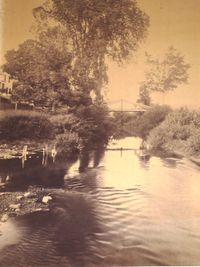Foxenkill

Description
Fox Creek. The Fox Creek flows for approximately 11.7 miles in the Town of Berne. Its headwaters lie at the junction of Smokey Hollow Road and county Road 14. Historically the Fox Creek was of commercial importance in that it supported two mills. Lobdell’s Grist Mill was located in East Berne (Historic Site 15), while Carding and Fulling Mills (Historic Site 5) were located in Berne. The Fox Creek is subject to flooding along its entire course throughout the town of Bern
Fox Creek, also called Foxenkill, originates in the highlands in the east end of the Town of Berne. It flows west through East Berne, then the hamlet of Berne where the Berne Falls tumbles down over rock out-crops, then flows placidly onward to West Berne and finally empties into Schoharie Creek.
A short distance west of the Berne hamlet it is joined from the south by the Switzkill.
Here is a map of the Foxenkill / Fox Creek
Access
- Fox Creek Park - A pocket park in the hamlet of Berne just below the falls.
- Berne Town Park - At the west end of the hamlet of Berne is on the creek.
Visitor facilites
Visitor facilities in the vicinity:
- Knox visitor attractions and facilities
- Berne visitor attractions and facilities
- Rensselaerville visitor attractions and facilities
- Westerlo visitor attractions and facilities
Problems
- Limited public access - Years ago NYS stocked trout in Berne; but that stopped because there is no legal public access.
- Pollution - Neither the Foxenkill nor the Switzkill are good habitat (both are too warm, and some pollution in the Foxenkill) to support a healthy population of trout.
- - Human sewage pollution from houses in the hamlets of East Berne and West Berne and elsewhere along the creek is a major pollution problem. Houses and businesses in the hamlet of Berne will soon be connected to a new sewage system in the hamlet that will be constructed in the next few years.
- - Non-point pollution control, especially agricultural runoff due to fertilizers and to cattle.
- There is excessive bank erosion due to lack of vegetation along the stream bed.
Proposals
- Establish a cut line to protect banks of the Foxenkill to allow the banks of the creek to regrow and to prevent cattle from grazing too close to the creek.
- Plant trees and shrubs along the banks to help prevent both bank erosion and at the same time cooling the waters for trout. Volunteers could undoubtedly be found to plant a few trees and bushes along the banks of deep pools on the creeks so as to improve trout habitat.
- Increase public access.
- - The hamlet of Berne turns its back on Fox Creek, which if treated right, would be a valuable resource for the hamlet. Perhaps the land on the south side of the Foxenkill between Fox Creek Park and Berne Town Park could be bought. The land has not much value to its present absentee owner because of it's inaccessibility from the main Yarmchuk farm which is on the opposite bank. On the other hand, it is very accessible from the hamlet side, especially the school, and would be a valuable addition to Fox Creek Park. If the land can not be bought cheaply, perhaps a right-of-way for a trail could be purchased or would be given to the town. The trail could be used by the school's cross country team, by kids going to school from the eastern part of the hamlet, and by hikers and photographers taken with the serene beauty of the Foxenkill.
- - Develop a Fox Creek Trail along the banks of the creek.
- Non-point pollution control, especially agricultural runoff, should be corrected through volunteer participation in federal programs at no cost to the farmer or loss of rights.
- Watershed Study - The town should consider undertaking a Foxenkill and Switzkill Watershed Study.
Gallery
- Fox Creek near Foxenkill Lodge.jpg
Fox Creek near Foxenkill Lodge<br.>ca. 2003, Jeremy Rue - B1389FoxCreekBridgeBerneColor.jpg
Fox Creek, Berne, N. Y., in the Helderbergs - B137FallsFoxCreekBerneColor.jpg
The Falls, Fox Creek, Berne, N. Y., in the Helderbergs - B140FoxCreekBerneColor.jpg
Fox Creek, Berne, N. Y., in the Helderbergs
Notes
- ↑ A king post truss is used for short-span bridges. It is the simplest form of truss in that it is constructed of the fewest number of truss members (individual lengths of wood or metal). The truss consists of two diagonal members that meet at the apex of the truss, one horizontal beam that serves to tie the bottom end of the diagonals together, and the king post which connects the apex to the horizontal beam below. A bridge would require two king post trusses with the driving surface between them.
Here is a photo of a king post replica bridge over the Plattekill Creek: File:King post replica bridge.jpg



